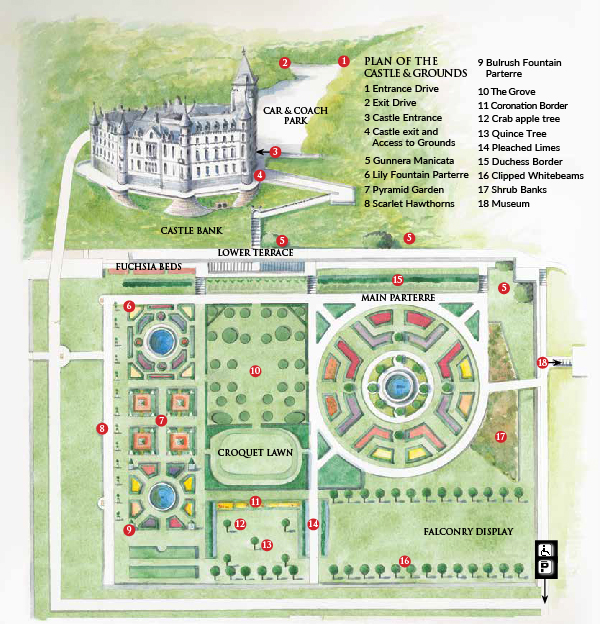The gardens were laid out in 1850 by the architect Sir Charles Barry, who was responsible for the Victorian extension to the Castle and who designed the Houses of Parliament.
Inspiration came from the Palace of Versailles in Paris, and they have changed little in the 150 years since they were planted, although new plants are constantly being introduced. Despite its northerly location, the sheltered gardens are able to support a surprising range of plants, including at the foot of the steps leading to the garden a huge clump of Gunnera manicata, a native rhubarb of South America that has eight foot leaves!

PLEASE NOTE
With the exception of Guide dogs, pets are not permitted in the formal gardens. However they are more than welcome to explore the woodlands surrounding the castle.
The gardens provide the cut flowers for the displays throughout the Castle. A visit to Dunrobin’s garden is of interest to all and most particularly for the connoisseur of the formal Victorian garden.
Sir Charles Barry’s layout of the formal gardens below the Castle, with their arrangement into two parterres both laid out around circular pools with fountains were inspired by the gardens of Versailles. Barry had also previously designed a vast Italianate garden for the 2nd Duke of Staffordshire’s estate at Trentham. Dunrobin’s gardens have changed little from Barry’s design of 150 years ago, although new plants are constantly being introduced.
Back then Dunrobin’s head gardener used to manage two walled gardens, including fruit, vegetables and flower borders; back up nursery gardens and greenhouses; and beyond, extensive parkland with walks and coastal views. Although much of this has reverted to woodland, the surviving east walled garden with its three parterres each surrounding a pool and fountain provides the perfect layout to view from the Castle. The gardens also make a fitting foreground to the panoramic view across the Moray Firth to the distant Cairngorm mountains.
Make your way down the steps and you will find a jewel of a garden, full of colour, interest and unexpected features, nestling amongst sheltering trees on a raised shingle beach; from here the Castle towering above provides a splendid backdrop.
Dunrobin is not a garden that only looks back. A small, dedicated team provides a continuity of generations-old gardening skills with careful use of up-to-date horticultural techniques to maintain, develop and take forward what remains.
The design is much as Barry left it but there have been recent exciting refurbishments to the planting and ornamentation. This includes avenues of Tuscan laurel and Whitebeam and the construction of wooden pyramid features. The old method of tree culture, pleaching, has also been re-introduced.
A fine line of clipped topiary whitebeams and a maturing line of red hawthorns in wooden tubs are recent developments, which echo the garden’s Italianate origins. Nearby a new garden in the style of a 19th century French potager and featuring 20 giant wooden pyramid plant supports is the boldest project to date and frames a new vista across the garden.
Despite its location so far north, the Gulf Stream of warm sea water that flows from the Gulf of Mexico across the Atlantic brings sub-tropical conditions to western gardens from the Isles of Scilly to the North West Highlands goes on to sweep round Cape Wrath and John o ’Groats making its final influence felt at Dunrobin. The sheltered gardens are able to support a surprising range of plants, including at the foot of the steps leading to the garden, a huge clump of giant rhubarb, Gunnera manicata, a native of South America. This plant attracts much attention as its leaves measure eight feet. A native of Brazil and Colombia, it thrives in the mild winters and shelters between the Castle and the sea. Fuchsias too thrive. Previous head gardeners raised their own varieties and Fuchsia ‘Dunrobin Bedder’ may still be seen in the borders as well as bold clumps of Fuchsia magellanica var. miolinae with its flowers of palest shell pink and great banks of Fuchsia magellanica ‘Riccartonii’ with masses of small crimson and purple flowers.
Three box-edged parterres of ascending antiquity carry a succession of colourful floral displays round the garden as the season progresses. April sees early tulips in the lily fountain beds and week by week spring bedding then summer bedding schemes interspersed with displays of perennial geraniums and lilies take the season through to the finish with a blaze of late summer dahlias. Backed by the retaining wall of the Castle terrace the Duchess Border, dating in its present form from the 1920s, is a majestic sight. Long summer days so far north make for exceptionally tall herbaceous plants and between the buttresses of the wall, Californian lilies flower with early 20th century climbing hybrid tea roses, now rarely seen. Also enjoying the warm influence is Choisya ternata the Mexican orange blossom forming clipped evergreen mounds in a sheltered corner, its heavily-scented white flowers attracting butterflies and moths on summer evenings.
Falconry is the ancient art of hunting with birds of prey.
A visit to Dunrobin Castle now includes daily birds of prey flying demonstrations on the Castle lawn. See spectacular shows featuring Peregrine and Gyrfalcon as well as Harris hawks. Learn more about other local birds of prey as well as the ancient art of falconry.
Our resident falconer demonstrates and explains the different hunting methods used by owls, hawks and falcons in a series of fascinating aerobatic displays. Every show creates superb photographic opportunities.
Falconry was originally developed as a means of hunting fast or difficult prey as food for the table, and is still practiced for this purpose in many parts of the world today.
To train one of these fierce and fabulous birds is a long and difficult process and requires patience, expertise and dedication. Dunrobin Castle is proud to be able showcase this ancient art.
Falconry Displays will be
1st April to the 31st October 11.30am and 2.30pm